Annex A — Propagation Curves
For the purposes of estimating field strength, when using the propagation curves in this annex, any HAAT values exceeding 1 600 metres will have to be entered as 1 600 metres.
Figure A1: Propagation Curves F(50,50) for Channels 2-6

Figure A2: Propagation Curves F(50,10) for Channels 2-6
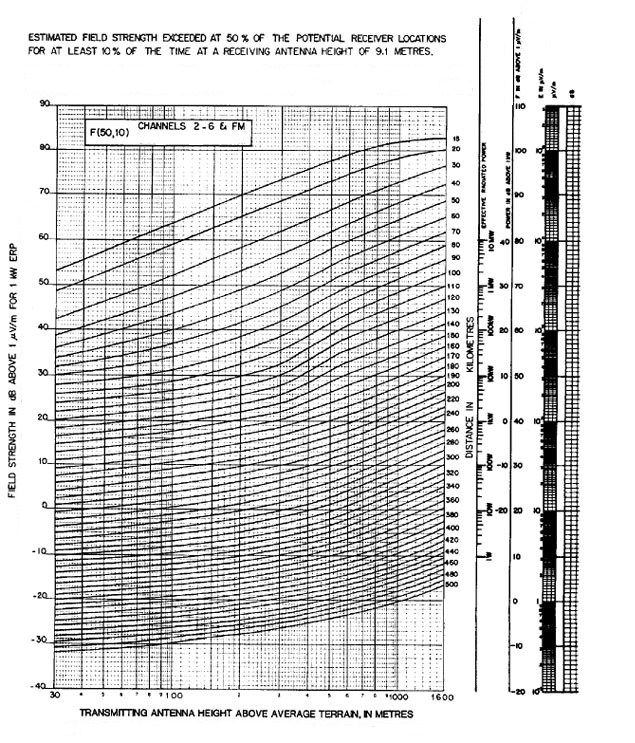
Figure A3: Propagation Curves F(50,50) for Channels 7-13

Figure A4: Propagation Curves F(50,10) for Channels 7-13
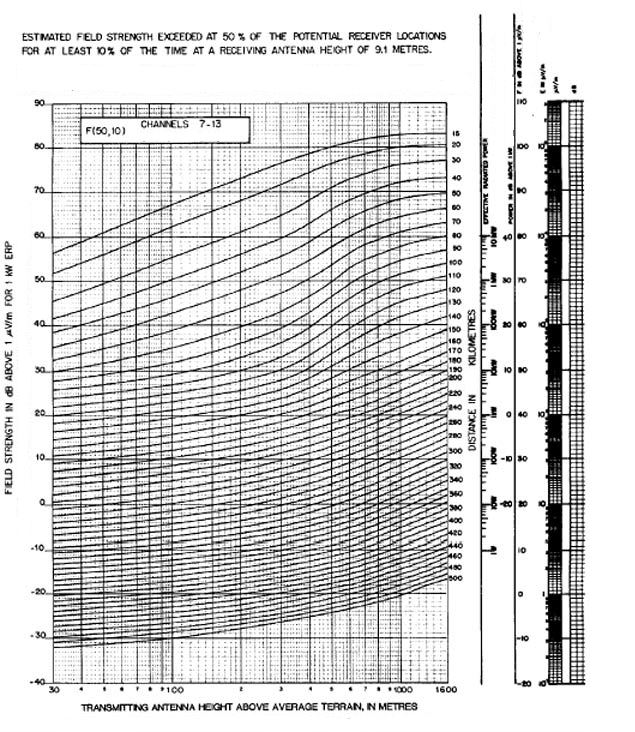
Figure A5: Propagation Curves F(50,50) for Channels 14-69
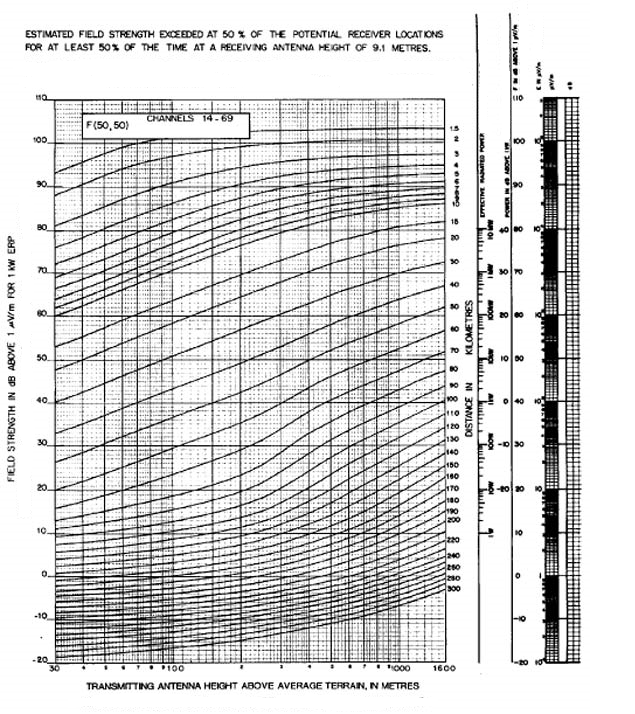
Figure A6: Propagation Curves F(50,10) for Channels 14-69
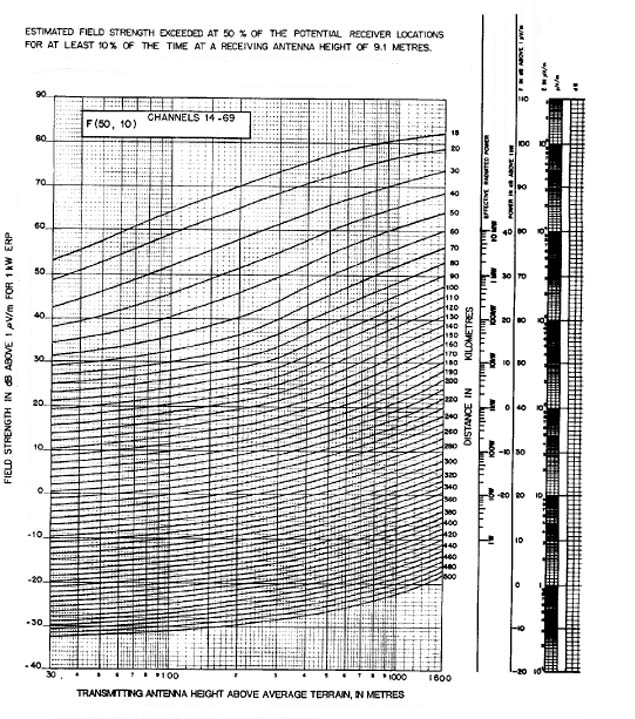
Annex B — Summary Sheet
(including province)
(if rebroadcasting)
(WGS84)
(w.r.t. Half-Wave Dipole)
(at beam tilt, if applicable) (Horizontal / Elliptical Polarization)
(Horizontal / Elliptical Polarization)
( ) Unattended ( ) Ancillary Service
Annex C — Elevation Diagram of Typical Tower and Transmitting Antenna
Figure C1 — Elevation Diagram of Typical Tower and Transmitting Antenna
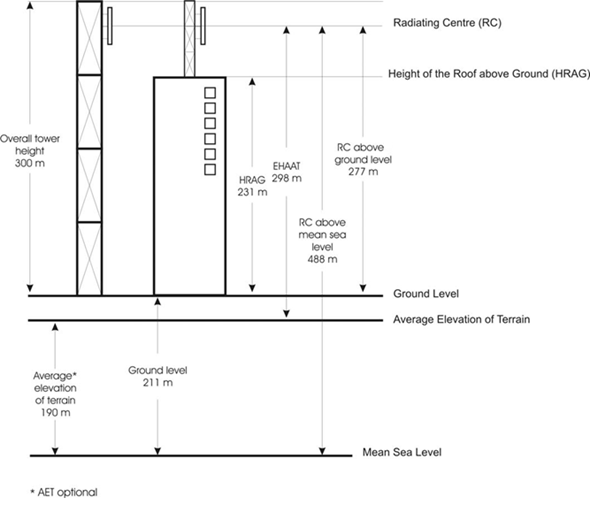
Annex D — F(50,50) Field Strength Curves
Figure D1: 47 dB Above 1 Microvolt per Metre Contour Channels 2-6

Transmitting Antenna Height (metres)
Figure D2: 56 dB Above 1 Microvolt per Metre Contour Channels 7-13

Figure D3: 64 dB Above 1 Microvolt per Metre Contour Channels 14-69
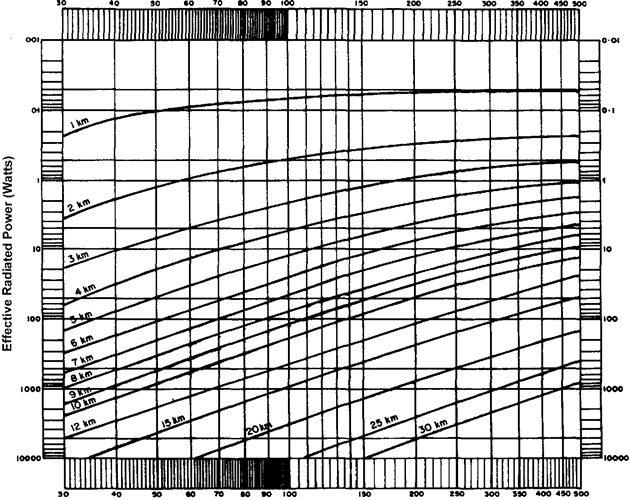
Transmitting Antenna Height (metres)
Annex E — Distance Versus Depression Angle (For Various Antenna Heights)
Figure E — Distance Versus Depression Angle (For Various Antenna Heights)
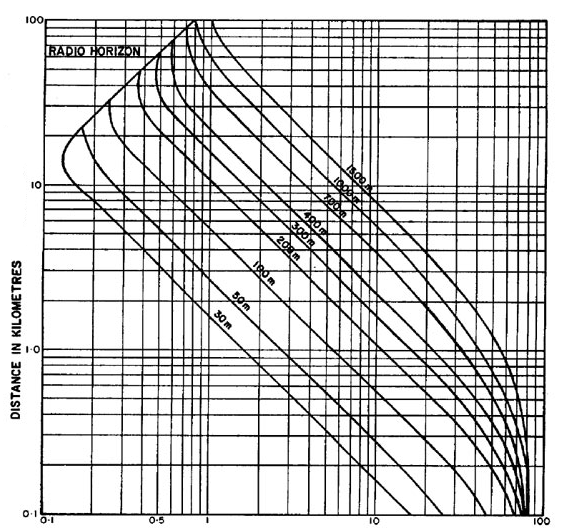
Depression Angle (in degrees)
Annex F — Procedure to Determine Interference Zone
On an appropriately scaled map plot the transmitter sites and do the following:
- Plot the protected service contour for the assignment or allotment to be protected, based on the maximum or other permissible parameters, as shown in Section 3.1.2.
- Plot the interfering contour for the proposed assignment or allotment based on its proposed parameters in accordance with the interfering signal levels as shown in Section 3.1.4.
- Mark the two points where the contours intersect.
- Repeat steps 1, 2 and 3 except increase the value of each contour while maintaining the same protection ratio until the protected and interfering contours are tangential.
- Draw a line joining the intersection points obtained above. The area contained within this line and the protected service contour drawn in Step 1 defines the interference zone.
Example
The following example shows the interference zone between an existing UHF Class B station and a proposed Class A station which are short-spaced and on co-channels.
- The protected service contour from Section 3.1.2 is 64 dBu which extends to 45 km.
- The interfering contour from Section 3.1.4 is 46 dBu (the extent of this contour will vary depending on the proposed operating facilities).
- Mark the two points where the contours intersect.
- Plot the 66 dBu service contour and the 48 dBu interfering contour and mark the two points of intersection. Continue to increase the value of the contours, plot them, and mark the intersection points until the contours are tangent.
- Draw a line joining the intersection points obtained above. The area contained within this line and the protected service contour drawn in step 1 defines the interference zone. This area is shown cross-hatched in the drawing.
Figure F1: Interference Zone
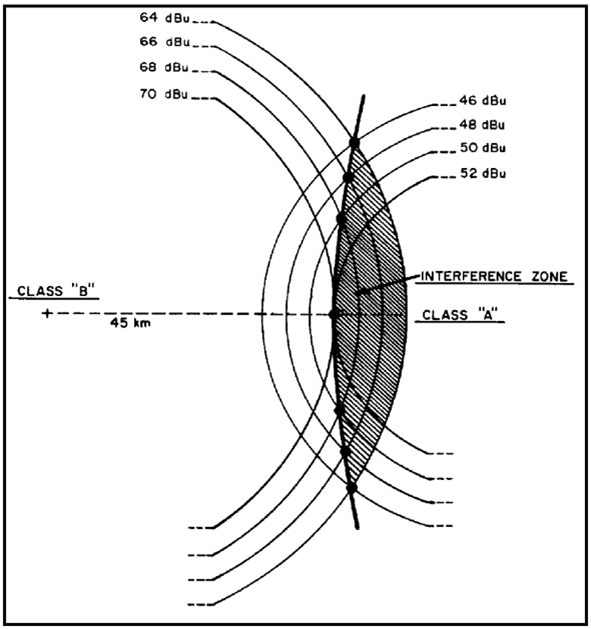
Annex G — Television Ghost Investigation
Figure G1: Ghost Delay Versus Ghost Level for a Given Picture Grade
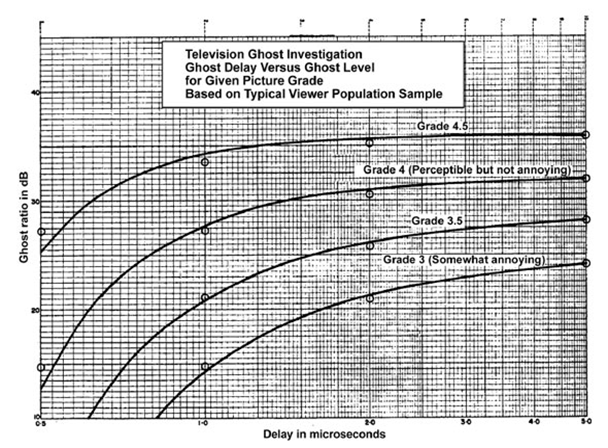
Annex H — Protection Criteria
| Channel Separations | Protection Criteria |
|---|---|
| ± 1 | The maximum permissible F(50,10) signal at the protected Grade B contour is equal to 100 dBu |
| ± 2, ± 3 | No overlap of 100 dBu contours calculated with F(50,50) curves |
| ± 4 | Protected site outside of proposed 74 dBu F(50,50) contours |
| -7 | No overlap of 74 dBu contours calculated with F(50,50) curves |
| +14 | The maximum permissible F(50,10) signal at the protected Grade B contour is equal to 110 dBu |
| +15 | The maximum permissible F(50,10) signal at the protected Grade B contour is equal to 92 dBu |
Note: For international protection criteria, refer to the International Agreement.
For VHF allotments or assignments, where the separation is less than 96 km, the maximum permissible interfering signal at the adjacent channel's protected Grade B signal contour of a domestic assignment shall not exceed that shown in the table below using F(50,50) propagation curves.
| Separation between TX Sites (km) | Interfering Signal (dBu) | D/U Protection Ratio (dB) |
|---|---|---|
| Between 95 and less than 96 | 96 | -49 |
| Between 93 and less than 95 | 84 | -37 |
| Between 92 and less than 93 | 77 | -30 |
| Less than 92 | 72 | -25 |
| Separation between TX Sites (km) | Interfering Signal (dBu) | D/U Protection Ratio (dB) |
|---|---|---|
| Between 95 and less than 96 | 93 | -37 |
| Between 93 and less than 95 | 89 | -33 |
| Between 90 and less than 93 | 87 | -31 |
| Between 87 and less than 90 | 84 | -28 |
| Between 84 and less than 87 | 82 | -26 |
| Less than 84 | 81 | -25 |
| Class of Allotment / Assignment | Channel Separation "r", Number of Channels Above (+) or Below (-) the Reference Channel "n" | ||||||
|---|---|---|---|---|---|---|---|
| Co-channel | ± 1 Adjacent D/U = -16 dB at D = 74 dBu F(50,50) or D/U = -36 dB at D = 64 dBu F(50,50) | ± 2, ± 3 IM No overlap of D = 100 dBu F(50, 50) U = 100 dBu F(50,50) | + 4 Locate D = 74 dBu | - 4 Locate D = 74 dBu | |||
| Channel Accorded Protection n Desired (D) | Potential Interfering Channel n + r Undesired (U) | Non-offset | Offset | ||||
| D/U = 35 dB D = 64 dBu F(50,50) U = 29 dBu F(50,10) | D/U = 18 dB D = 64 dBu F(50,50) U = 46 dBu F(50,10) | ||||||
| * Protection Provided at Potential Interfering Channel 64 or 74 dBu Contour. | |||||||
| C | C | 353 | 250 | 88 | 36 | 53 | 53 |
| C | B | 328* | 225* | 77 | 25 | 53 | 30 |
| C | A | 308* | 205* | 73 | 21 | 53 | 15 |
| B | C | 328 | 225 | 77* | 25 | 30 | 53 |
| B | B | 248 | 153 | 52 | 14 | 30 | 30 |
| B | A | 228* | 133* | 48 | 10 | 30 | 15 |
| A | C | 308 | 205 | 73* | 21 | 15 | 53 |
| A | B | 228* | 133 | 48 | 10 | 15 | 30 |
| A | A | 163 | 85 | 28 | 6 | 15 | 15 |
| Class of Allotment / Assignment | Channel Separation "r", Number of Channels Above (+) or Below (-) the Reference Channel "n" | |||
|---|---|---|---|---|
-7 No overlap D = 74 dBu | + 14 D/U = -46 dB | + 15 D/U = -28 dB | ||
| Channel Accorded Protection n Desired (D) | Potential Interfering Channel n + r Undesired (U) | |||
| * Protection Provided at Potential Interfering Channel 64 or 74 dBu Contour. | ||||
| C | C | 106 | 80 | 99 |
| C | B | 83 | 74 | 82 |
| C | A | 68 | 72 | 75 |
| B | C | 83 | 55 | 74 |
| B | B | 60 | 49 | 57 |
| B | A | 45 | 47 | 50 |
| A | C | 68 | 35 | 54 |
| A | B | 45 | 29 | 37 |
| A | A | 30 | 27 | 30 |
Annex I — Minimum Distance Separations
| Class of Station/System | Channels 2-6 | Channels 7-13 | |||||
|---|---|---|---|---|---|---|---|
| Channel Separation "r", Number of Channels Above (+) or Below (-) the Reference Channel "n" | |||||||
| Co-channel | ± 1 Adjacent | Co-channel | ± 1 Adjacent | ||||
| Channel accorded protection (n) Desired (D) | Channel applied for (n + r) Undesired (U) | Non-offset | Offset | D/U = -16 dB D = 47 dBu F(50,50) U = 63 dBu F(50,10) | Non-offset | Offset | D/U = -16 dB D = 56 dBu F(50,50) U = 72 dBu F(50,10) |
| D/U = 35 dB D = 47 dBu F(50,50) U = 12 dBu F(50,10) | D/U = 25 dB D = 47 dBu F(50,50) U = 22 dBu F(50,10) | D/U = 35 dB D = 56 dBu F(50,50) U = 21 dBu F(50,10) | D/U = 25 dB D = 56 dBu F(50,50) U = 31 dBu F(50,10) | ||||
| Regular | LP | 209 | 159 | 94 | 158 | 123 | 85 |
| LP | LP | 132 | 82 | 17* | 88 | 53 | 11* |
Note 1: Distances are based on VHF low-power operations having 100 watts ERP and 30 m EHAAT and regular stations operating with the maximum values given under Maximum Permissible Parameters in Section 3.1.1. For other low-power parameters, the desired-to-undesired (D/U) ratios in the table must be satisfied.
Note 2: The Grade B contour is 12 kilometres and 8 kilometres respectively for channel 2-6 and 7-13.
Note 3: In principle, those distances marked with as asterisk (*) may be eliminated if stations are co-sited.
Note 4: Offset operations require a frequency stability of ± 1 000 Hz.
| Class of Station/System | Channels 2-6 | Channels 7-13 | |||||
|---|---|---|---|---|---|---|---|
| Channel Separation "r", Number of Channels Above (+) or Below (-) the Reference Channel "n" | |||||||
| Co-channel | ± 1 Adjacent | Co-channel | ± 1 Adjacent | ||||
| Channel accorded protection (n) Desired (D) | Channel applied for (n + r) Undesired (U) | Non-offset | Offset | D/U = -16 dB D = 47 dBu F(50,50) U = 63 dBu F(50,10) | Non-offset | Offset | D/U = -16 dB D = 56 dBu F(50,50) U = 72 dBu F(50,10) |
| D/U = 35 dB D = 47 dBu F(50,50) U = 12 dBu F(50,10) | D/U = 25 dB D = 47 dBu F(50,50) U = 22 dBu F(50,10) | D/U = 35 dB D = 56 dBu F(50,50) U = 21 dBu F(50,10) | D/U = 25 dB D = 56 dBu F(50,50) U = 31 dBu F(50,10) | ||||
| LP | Regular | 367 | 290 | 90 | 323 | 258 | 78 |
| LP | LP | 132 | 82 | 17* | 88 | 53 | 11* |
Note 1: Distances are based on VHF low-power operations having 100 watts ERP and 30 m EHAAT and regular stations operating with the maximum values given under Maximum Permissible Parameters in Section 3.1.1. For other low-power parameters, the desired-to-undesired (D/U) ratios in the table must be satisfied.
Note 2: The Grade B contour is 12 kilometres and 8 kilometres respectively for channel 2-6 and 7-13.
Note 3: In principle, those distances marked with as asterisk (*) may be eliminated if stations are co-sited.
Note 4: Offset operations require a frequency stability of ± 1 000 Hz.
| Class of Station/System | Channel Separation "r", Number of Channels Above (+) or Below (-) the Reference Channel "n" | |||||||
|---|---|---|---|---|---|---|---|---|
| Co-channel | ± 1 D/U = -16 dB | ± 2, ± 3, ± 4 D/U = 0 dB | - 7 Oscillator Radiation D/U = 0 dB D = 74 dBu F(50,50) U = 74 dBu F(50,50) | + 14 D/U =-28 dB | + 15 D/U = -10 dB | |||
| Channel accorded protection (n) Desired (D) | Channel applied for (n + r) Undesired (U) | Non-offset | Offset | |||||
| D/U = 28 dB D = 64 dBu F(50,50) U = 36 dBu F(50,10) | D/U = 18 dB D = 64 dBu F(50,50) U = 46 dBu F(50,10) | |||||||
| C | LP | 140 | 107 | 75 | 20 | 60 | 72 | 77 |
| B | LP | 115 | 82 | 50 | 9 | 37 | 47 | 52 |
| A | LP | 95 | 62 | 30 | 5 | 22 | 27 | 32 |
| LP | LP | 82 | 49 | 17* | 3* | 14 | 14* | 19 |
Note 1: Distances are based on a UHF low-power operating at 5 kW ERP and 30 metres EHAAT (with a Grade B contour of 12 kilometres) and other UHF stations operating with parameters according to the class designations shown under Maximum Permissible Parameters in Section 3.1.1. For other low-power parameters the desired-to-undesired (D/U) ratios in the table must be satisfied at the desired contour.
Note 2: In principle, those distances marked with an asterisk (*) may be eliminated if stations are co-sited.
Note 3: Offset operations require a frequency stability of ± 1 000 Hz.
| Class of Station/System | Channel Separation "r", Number of Channels Above (+) or Below (-) the Reference Channel "n" | |||||||
|---|---|---|---|---|---|---|---|---|
| Co-channel | ± 1 D/U = -16 dB | ± 2, ± 3, ± 4 D/U = 0 dB | - 7 Oscillator Radiation D/U = 0 dB D = 74 dBu F(50,50) U = 74 dBu F(50,50) | + 14 D/U =-28 dB | + 15 D/U = -10 dB | |||
| Channel accorded protection (n) Desired (D) | Channel applied for (n + r) Undesired (U) | Non-offset | Offset | |||||
| D/U = 28 dB D = 64 dBu F(50,50) U = 36 dBu F(50,10) | D/U = 18 dB D = 64 dBu F(50,50) U = 46 dBu F(50,10) | |||||||
| LP | C | 252 | 192 | 62 | 20 | 60 | 41 | 72 |
| LP | B | 175 | 122 | 35 | 9 | 37 | 24 | 44 |
| LP | A | 114 | 72 | 22 | 5 | 22 | 17 | 27 |
| LP | LP | 82 | 49 | 17* | 3* | 14 | 14* | 19 |
Note 1: Distances are based on a UHF low-power operating at 5 kW ERP and 30 metres EHAAT (with a Grade B contour of 12 kilometres) and other UHF stations operating with parameters according to the class designations shown under Maximum Permissible Parameters in Section 3.1.1. For other low-power parameters the desired-to-undesired (D/U) ratios in the table must be satisfied at the desired contour.
Note 2: In principle, those distances marked with an asterisk (*) may be eliminated if stations are co-sited.
Note 3: Offset operations require a frequency stability of ± 1 000 Hz.
Annex J — Zones One and Two Canada and U.S.A.
Figure J — Zones One and Two Canada and U.S.A.

Annex K — Television / Land-Mobile Mutual Interference Analysis (Provisional)
K1. Purpose
The purpose of this annex is to define the factors and to provide a method for evaluating mutual interference between land-mobile services and TV services on channel 7, 14 and 69 operating in adjacent frequency bands. It is to be noted that the present analysis does not deal with interference from multiple sources.
K1.1 Interference to Land Mobile
Interference to land-mobile base station receivers may occur when they operate near the site of a TV transmitter and on frequencies close to the TV channel (within 4 MHz). Such interference may be eliminated or reduced by increasing the physical separation of the stations.
The following are the types of interferences and possible remedies:
K1.1.1 Out-of-Channel Radiation From the Television Undertaking
This type of interference is produced intrinsically and with respect to the ambient "noise floor":
-
Out-of-channel radiation by the television transmitter which can intrinsically create interference to LM. Normal operation usually results in video components* up to -60 dB in the adjacent channel, reference level being the peak envelope visual power.
*Note: In the worst case, components as high as the below figures can exist for a few seconds at a time:
-40 dB @ fv- 4.5 MHz (aural image, 3.25 ± 0.01 MHz below channel edge)
-40 dB @ fv+ 9.0 MHz (visual image, 4.25 ± 0.01 MHz above channel edge)
-60 dB @ fv- 3.58 MHz (chroma image, 2.33 ± 0.01 MHz below channel edge)
-37 dB (worst case sporadic video components) down to 3 MHz below and up to 4 MHz above channel edge.Emissions at a specific frequency could, from a particular contributor, be reduced by a further 20 to 30 dB at the television transmitter by the use of special filters.
- LM usable sensitivity at VHF and UHF frequencies which is determined by internal noise and man-made noise. The sensitivity of a typical receiver is such that an input signal of 0.5 µV (-114 dBm, assuming a receiver input impedance of 50 Ω) would result in a 12 dB SINAD ratio at the output. To minimize the potential for interference to land-mobile receivers, out-of-channel television emissions at the specific LM carrier frequency and at the input of land mobile should ideally not exceed -120 dBm (assuming a signal to in terference ratio of 6 dB at that level).
While the above numbers apparently prohibit co-existence of LM and adjacent band television services except at great distances, statistical, technical and subjective factors have, in reality, proven that separation distances much lower than those implied by the theoretical numbers above can provide satisfactory results. In fact, a minimum separation distance** of 35 km is deemed to be sufficient for full power television undertakings. The minimum separation distance may be decreased by 3 km per dB of reduced ERP value to a minimum separation distance of 15 km.
**Note: The separation distance is based on out-of-channel (within 4 MHz from the edge of channel) TV emissions that are suppressed by 60 dB (referenced to peak envelope visual power), a receive LM antenna gain of 5 dB (10 dB for UHF) and a cross-polarization discrimination of 20 dB.
In real interference situations, the actual values that could be attributed to the above factors and in the note may differ from those assumptions. Additional factors such as TV antenna pattern, the degree of additional TV transmitter filtering and/or other rejections in the LM system may provide shorter separation distances.
The ambivalent nature of all these factors does not provide a sound foundation on which distance separation requirements could be based. The Department will therefore consider individual agreements between the TV applicant and the affected LM operators as an alternative to minimum separation distances.
K1.1.2 Desensitization of the Base Station Receiver
Interference can be minimized by installing cavity filters at the LM receiver to provide some rejection of the adjacent visual or aural carriers except where the frequency is too close.
K1.1.3 Intermodulation Products
Intermodulation products result from the mixing of two or more undesired signals at the input of the receiver. This may be eliminated by employing appropriate filters at the land-mobile receiver to reduce the magnitude of the TV signal contributing to the intermodulation product. If the intermodulation products are caused by mixing inside the receiver, upgrading the receiving equipment or better shielding may also alleviate the problem.
K1.2 Interference to Television
Figures K1 to K3 reflect measured values of protection ratio versus frequency separation for various channels.
In the case of channels 7 and 14, if a land-mobile transmitter of relatively high power is operating on a frequency near 2.33 MHz below the edge of the channels, a mixing process takes place producing severe color interference. For other frequencies in the lower 4 MHz adjacent band of channels 7 and 14 or in the entire upper adjacent 4 MHz band of channel 69, interference to television generally takes the form of distortion of the luminance information.
The potential for interference in the second, third and fourth adjacent TV channel is negligible.
LM assignments in the frequency band beyond 4 MHz from the edge of television channels can operate within the television service contour and provide the required protection. Within 4 MHz, however, full protection to television service from LM base station operations may be provided either through co-siting the TV transmitting antenna with the related adjacent channel LM base station transmitter, or by selecting the television site in such a way to keep the LM base station outside the proposed service contour (Grade B) where the protection ratios are met. These options may prove to be impractical in some cases due to location.
Co-siting TV and LM transmitters will result in a uniform signal differential inside the service contour of the television undertaking. The best approach to co-siting is to locate both the TV and LM transmitting antennas on the same tower or supporting structure. In such cases, similar antenna patterns are not needed as long as the TV/LM effective radiated power (ERP) ratio meets or exceeds that implied in Table K3. For best results, the LM receiver(s) should be kept at some distance rather than at the transmitting antenna site.
When not co-located, LM base station transmitters inside a television service contour will establish pockets of interference the size of which varies depending on the frequency separation and the strength of the television signal. As the separation distance between the two stations increases, the field strength of the TV signal decreases enlarging progressively the size of the area of interference. For all such cases, the applicant shall indicate the presence of interference zones from the related LM assignments on the coverage map. The interfering field strength of the land-mobile station may be calculated using the propagation curves of Figure K4.
Viewing tests were conducted in 1989 (refer to report BTRB-7 entitled Protection to Television from Land Mobile Stations Operating Adjacent to Television Channels 7, 13, 14 and 69) to determine the susceptibility of television receivers to adjacent band LM interference. LM signals in the frequency bands adjacent to channels 7, 14 and 69 were applied to the receiver terminals and the levels were adjusted for "Just Perceptible" interference. The viewing conditions for the assessment of picture quality were in accordance with the Recommendation ITU-R BT.500. The TV signal at the receiver terminal was adjusted to -25, -35 and -55 dBm (dB above 1 mW).
The average protection or rejection ratios obtained at the laboratory are based on non-varying desired and undesired input voltages at the receiver. In practice, it is necessary to define the percentage of time as well as the percentage of locations for which the desired quality of service is met.
The picture quality for coverage inside the Grade A (or Grade B) contour is defined as a picture of acceptable quality for at least 70% (50% for the Grade B) of receiver locations and 90% of the time. If F(50,50) propagation curves are used inside these contours, a time probability factor (T) and a location probability factor (L) have to be used to account for signal fading and terrain irregularities respectively. Consequently, protection to television reception from LM base station transmitters is derived from the following formula:
where:
Fu and Fd are the undesired LM and desired TV signal levels respectively. Fu is calculated by the free space propagation model out to 1 km. The "Egli propagation model" for 50% of locations is to be used for distances of in excess of 2 km (refer to Figure K4 of this annex). Interpolation is used to join the curves for distances of between 1 and 2 km. Fd is calculated by using the F(50,50) propagation curves. Figure K4 indicates the field strength for typical land-mobile stations with an ERP of 125 W (VHF) and 250 W (UHF). The appropriate field strengths for other ERP values can be obtained by shifting the curves ± 6 dB vertically for each multiplication/division of the ERP by a factor of 2. Field strengths are expressed in dBu.
PR is the average protection ratio in dB obtained from the receiver measurements (see figures K1 to K3 in this annex);
AD is the combined cross-polarization and directional discrimination of the TV receiving antenna against LM signals in dB (AD ≈15 dB when LM base station outside the Grade B, otherwise, AD = 0 dB);
H(L) is the adjustment made in dB with respect to the percentage of locations where the desired field strength level will be above the calculated value;
H(T) is the adjustment made in dB with respect to the percentage of time when the desired field strength level will be above the calculated value.
| Inside | H(L) (in dB) | H(T) (in dB) | Total (in dB) |
|---|---|---|---|
| Grade A | 4 | 3 | 7 |
| Grade B | 0 | 5 | 5 |
| Inside | H(L) (in dB) | H(T) (in dB) | Total (in dB) |
|---|---|---|---|
| Grade A | 6 | 3 | 9 |
| Grade B | 0 | 4 | 4 |
K.1.2.1 Near the Grade B Contour
The protection ratios of figures K1 to K3 are average values obtained at a TV receiver input level of -55 dBm. This level of signal represents viewing conditions close to the edge of the protected contour.
K.1.2.2 Co-located (Same Tower) TV and LM Transmitters
For TV receiving locations near the transmitting site, the television signal levels will be very high and therefore outdoor receiving antennas are not normally used. The reduced antenna size (rabbit ears) and its reduced height above ground limit the actual level. Measurements have indicated that the TV signal into the receiver using an indoor antenna inside the Grade A contour is usually between -25 and -35 dBm. In addition, it is assumed that the indoor TV receiving antenna provides no cross-polarization discrimination and indeed very little directional discrimination against vertically polarized LM transmissions, hence:
AD = 0 dB
Table K3 (below) gives the average values of the protection ratio for television. These are based on a receiver input level of -35 dBm (inside the Grade A contour). The ratios for -25 dBm are somewhat similar since they do not exhibit significant dependence on the level of the desired television signal.
| TV Channels | Frequency Separation (in MHz) of LM Base Station From the Edge of the TV Channel | Protection Ratio (dB) at the Input of the Television Receiver |
|---|---|---|
| 7 and 14 | 2 - 3 | +12 |
| > 3 | 0 | |
| 69 | > 2 | +3 |
Figure K1: Desired (TV) to Undesired (LM) Protection Ratio Curves for Channel 7

Figure K2: Desired (TV) to Undesired (LM) Protection Ratio Curves for Channel 14
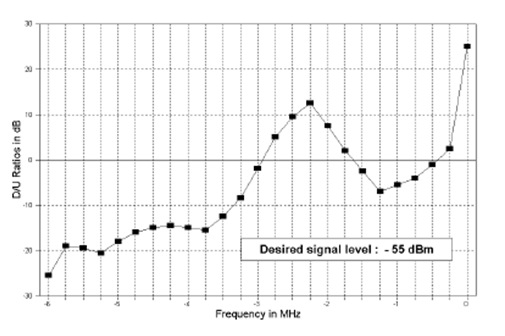
Figure K3: Desired (TV) to Undesired (LM) Protection Ratio Curves for Channel 69
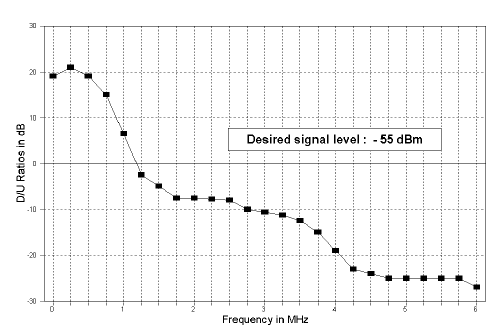
Figure K4: Field Strength of Land Mobile Stations

